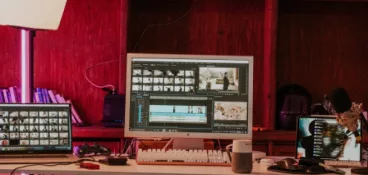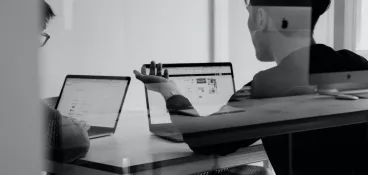The medical, legal, and regulatory affairs (MLR) review process is a headache. There, I said it. It’s slow, communication is siloed, and version management is pretty much non-existent.
But it doesn’t have to be. Let’s look at the four most common problems in the MLR review process for pharma teams and how you can solve them.
If you’d like to learn more about MLR reviews first then check out our full explainer.
1. No transparency between reviewers
Transparency is the key to effective collaboration in the medical peer review process. Without it, feedback gets scattered in lots of different places.
I’m sure you’ve been there. You email a PDF to three people asking for their feedback. One sends their suggestions in an email, but it’s only addressed to you. The other two download the PDF and add their comments. One of them replies in the original thread but, just to mix things up, the other one sends it to you on Microsoft Teams.
Then you proceed to pull your hair out.
Why it’s a problem
When reviewers aren’t talking, it creates extra work for marketers and creatives. It also increases the risk of missing an important piece of feedback.
Here’s why no transparency is a problem in the MLR process:
- Feedback is scattered across different tools, documents, and email chains
- Someone has to waste time consolidating all the comments in one place
- There’s a high risk of missing or overlooking an important piece of feedback
- Meetings are needed to discuss conflicts before moving forward
How to solve it
To improve transparency across your medical review process, you need to get your reviewers on the same page from the start.
Upload your digital content to Filestage’s MLR review software, then invite your teammates to a review step to collect all their feedback in one place.
They can highlight text, add comments, and upload attachments to give crystal clear feedback. But best of all, they can discuss disagreements and get aligned in real time.

2. Losing track of which version is the latest
Online documents are a beautiful creation. They make it easy for anyone to dive in and make changes. And if you don’t have edit access, you can make a copy, edit the new version, and send that one to everyone instead.
What.
Could.
Possibly.
Go.
Wrong?
A lot, as it turns out. Without careful supervision, online documents can quickly become the enemy of version management.
Why it’s a problem
Writers and creatives spend a huge amount of time going through feedback to make changes to their work. But if that feedback was shared based on a previous version and is already out of date, well, @#$%&!
Why poor version management is a problem in the MLR process:
- Multiple versions are shared with no consolidation or agreement
- Reviewers can edit documents directly, creating even more confusion
- Writers waste time editing content based on out-of-date feedback
- Old versions can be published by mistake
How to solve it
To make sure everyone in your review team knows which piece of content is the latest, you need to draw a clear line between each version.
One way to solve this is by downloading documents as PDFs. This will stop reviewers from making edits directly, but you may still have issues with multiple versions circulating the team.
If you want to automate version management across all your projects, share your content in Filestage. Every new file will automatically be tagged as v1 so everyone knows they’re looking at the same thing. And when you upload v2, v3, or even v9, reviewers will be notified straight away, and they’ll even be able to refer back to previous versions to see what’s changed.
On top of that, Filestage can also be used as a powerful file comparison tool, allowing you to auto-compare documents to highlight changes – dramatically reducing review time.

3. Giving feedback on video content
Video is huge in the world of life sciences, pharmaceuticals, and biotech. From key opinion leaders (KOLs) to social media content, it’s an essential part of the healthcare marketing mix.
But if MLR review processes are slow for documents, they’re crippling for videos.
Why it’s a problem
To get feedback on your videos, you need a simple and secure way to share them. And if you’ve ever had to re-upload your content because the file-sharing link timed out, you’ll know how frustrating it can be.
But that’s just the tip of the iceberg.
Your reviewers can’t highlight part of a video to add a comment like they do in Google Docs (actually, they can). And you can’t click on a comment to jump to the exact part of the video they were talking about (believe it or not, you can do that too, but we’ll get to that in a second).
Why giving feedback on video content is a problem in the MLR process:
- Reviewers need to write out timecodes, take screenshots, and send long descriptions to make their feedback clear
- Other reviewers don’t bother, leaving things open to interpretation
- Video editors waste hours piecing all the feedback together
How to solve it
You can upload video content to Filestage, just like you would with documents, designs, images, and even live websites.
Reviewers can then click anywhere to add feedback right on top of your content, automatically creating a timestamp in the comments. They can even draw annotations and upload attachments to help explain what they mean.

4. Promotional review committee (PRC) meetings
PRC meetings are legendary for pharmaceuticals, biotech, and life sciences companies. They are the mountain all marketing materials and pharmaceutical packaging designs have to climb.
Usually taking place at set times in the month, marketers are given strict deadlines to submit content for review by the PRC. The PRC, a committee of medical, legal, and regulatory affairs reviewers, then checks the work and sends back an edited or annotated version.
Job done? Not quite.
Why it’s a problem
As the healthcare world becomes more distributed, hybrid working is fast becoming the norm. Suddenly, the PRC has gone virtual.
The PRC usually meets once a week or fortnight to discuss the latest marketing submissions. But with these meetings often lasting four hours or more, Zoom-fatigue has kicked in.
Why PRC meetings are a problem in the MLR process:
- They are draining for the medical, legal, and regulatory review team
- Submission dates are rigid and rely on everyone being able to get in a room, even a virtual one, at the same time
- Marketers aren’t involved in PRC meetings, so they can’t collaborate, discuss, or learn from edits in real time
- New versions can’t be reviewed until the next PRC meeting
How to solve it
To make the virtual PRC a success, teams need to commit to the idea of a digital MLR review process. That means making better use of collaborative, asynchronous tools – similar to the way you communicate on Slack or Microsoft Teams.
The easiest and most effective way to do this is by creating review steps in your Filestage projects. You can set up separate review groups for each part of the pharmaceutical promotional review process, including medical, legal, and regulatory.
This makes MLR review management easy. You can share new content or versions with the PRC in just one click. And your reviewers can share feedback and reply to comments when it suits their schedule.

Final thoughts
MLR reviews are critical for maintaining your brand’s reputation and avoiding lawsuits over marketing campaigns. But they’re notoriously difficult to manage.
Filestage makes it easy to share any content type with your MLR review team, all in one place. This improves transparency and version management, speeds up content reviews, and makes the process more collaborative for everyone.






